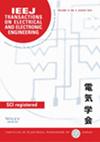求助PDF
{"title":"Cooperative Path Planning for Persistent Surveillance in Large-Scale Environment with UAV-UGV System","authors":"Jiahui Wang, Kai Yang, Baolei Wu, Jun Wang","doi":"10.1002/tee.24157","DOIUrl":null,"url":null,"abstract":"<p>In this paper, we consider the path planning problem of the Unmanned Air-Ground Vehicle (UAV-UGV) system for large-scale environmental persistent surveillance. The goal is to acquire a set of periodically visited surveillance nodes while minimizing the traveling distance. Some expected key problems are the limitations of UAV speed, UGV speed, UAV endurance, and UAV field of view. To address this issue, the path planning of UAV-UGV surveillance system is modeled as a TSP optimization problem based on multiple constraints, aiming to minimize the total path length of the system to perform the task. UAV is responsible for visiting the surveillance node and UGV serves as a mobile charging station. And a two-layer chaotic aptenodytes forsteri optimization algorithm (Two-CAFO) is proposed to solve this problem. Our solution has been tested in several simulated and real-world environments. The results demonstrate that the proposed Two-CAFO has superior performance compared to other state-of-the-art algorithms in solving the path planning problem for large-scale environmental persistent surveillance tasks of UAV and UGV. © 2024 Institute of Electrical Engineers of Japan and Wiley Periodicals LLC.</p>","PeriodicalId":13435,"journal":{"name":"IEEJ Transactions on Electrical and Electronic Engineering","volume":"19 12","pages":"1987-2001"},"PeriodicalIF":1.0000,"publicationDate":"2024-06-30","publicationTypes":"Journal Article","fieldsOfStudy":null,"isOpenAccess":false,"openAccessPdf":"","citationCount":"0","resultStr":null,"platform":"Semanticscholar","paperid":null,"PeriodicalName":"IEEJ Transactions on Electrical and Electronic Engineering","FirstCategoryId":"5","ListUrlMain":"https://onlinelibrary.wiley.com/doi/10.1002/tee.24157","RegionNum":4,"RegionCategory":"工程技术","ArticlePicture":[],"TitleCN":null,"AbstractTextCN":null,"PMCID":null,"EPubDate":"","PubModel":"","JCR":"Q4","JCRName":"ENGINEERING, ELECTRICAL & ELECTRONIC","Score":null,"Total":0}
引用次数: 0
引用
批量引用
Abstract
In this paper, we consider the path planning problem of the Unmanned Air-Ground Vehicle (UAV-UGV) system for large-scale environmental persistent surveillance. The goal is to acquire a set of periodically visited surveillance nodes while minimizing the traveling distance. Some expected key problems are the limitations of UAV speed, UGV speed, UAV endurance, and UAV field of view. To address this issue, the path planning of UAV-UGV surveillance system is modeled as a TSP optimization problem based on multiple constraints, aiming to minimize the total path length of the system to perform the task. UAV is responsible for visiting the surveillance node and UGV serves as a mobile charging station. And a two-layer chaotic aptenodytes forsteri optimization algorithm (Two-CAFO) is proposed to solve this problem. Our solution has been tested in several simulated and real-world environments. The results demonstrate that the proposed Two-CAFO has superior performance compared to other state-of-the-art algorithms in solving the path planning problem for large-scale environmental persistent surveillance tasks of UAV and UGV. © 2024 Institute of Electrical Engineers of Japan and Wiley Periodicals LLC.
利用 UAV-UGV 系统在大规模环境中进行持久监视的合作路径规划
在本文中,我们考虑了用于大规模环境持久监视的无人驾驶空地飞行器(UAV-UGV)系统的路径规划问题。目标是获取一组周期性访问的监控节点,同时最大限度地减少移动距离。一些预期的关键问题是 UAV 速度、UGV 速度、UAV 续航时间和 UAV 视野的限制。为解决这一问题,UAV-UGV 监视系统的路径规划被建模为基于多约束条件的 TSP 优化问题,旨在最小化系统执行任务的总路径长度。UAV 负责访问监控节点,UGV 充当移动充电站。为了解决这个问题,我们提出了一种双层混沌天体优化算法(Two-CAFO)。我们的解决方案已在多个模拟和实际环境中进行了测试。结果表明,与其他最先进的算法相比,所提出的 Two-CAFO 在解决 UAV 和 UGV 的大规模环境持久监视任务的路径规划问题方面具有更优越的性能。© 2024 日本电气工程师学会和 Wiley Periodicals LLC。
本文章由计算机程序翻译,如有差异,请以英文原文为准。

 求助内容:
求助内容: 应助结果提醒方式:
应助结果提醒方式:


